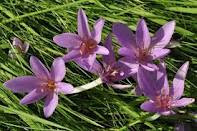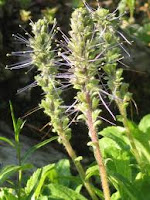The Autumn Crocus is not a relation to Crocus sativa from which we get saffron, which is in the Iridaceae family of plants. This one was formerly in the Liliaceae (lily) family but has recently been moved to the Colchiaceae family. It has light purple or white flowers and as its name suggests, flowers between September and October during early autumn and grows in meadows.
 It is native to Europe and North Africa, but is restricted in range now in Britain to an area around the Bristol Channel.
It is native to Europe and North Africa, but is restricted in range now in Britain to an area around the Bristol Channel.
 It is native to Europe and North Africa, but is restricted in range now in Britain to an area around the Bristol Channel.
It is native to Europe and North Africa, but is restricted in range now in Britain to an area around the Bristol Channel. All parts of the plant are poisonous to cattle and the corm or bulb from which the plant grows contains the alkaloid colchinine which is highly toxic. A woman was convicted of poisoning in 1862 using the drug Colchium. This was considered virtually a specific treatment for gout in the 18th century, and was used extensively with imported corms being used in Britain. The corms used were cultivated for medicinal purposes in France and Germany.
Autumn Crocus has a long history of use, although writing in his Des Materia Medica in the first century AD, Dioscorides records that it is a poison. Despite this knowledge, it was used in the Byzantine Empire for joint problems such as rheumatism and arthritis. It was the Arabs who first realized that it could be used to treat gout effectively.
 The plant is a drastic purgative and can be fatal to humans as it is to cattle which inadvertently graze on the leaves. However topically it can be applied to neuralgia and itching to bring relief – although so can other herbs which are safer to use. It should never be used during pregnancy or when lactating, and neither should it be used by people who suffer from kidney problems.
The plant is a drastic purgative and can be fatal to humans as it is to cattle which inadvertently graze on the leaves. However topically it can be applied to neuralgia and itching to bring relief – although so can other herbs which are safer to use. It should never be used during pregnancy or when lactating, and neither should it be used by people who suffer from kidney problems. It is also not a good idea to harvest it as some cases of poisoning have occurred when people have mistaken it for ramsons or wild garlic, Allium ursinum, also called bear’s garlic and cooked the leaves or corms.
In the Language of Flowers the Autumn Crocus or Meadow Saffron stands for “my best days are gone; I am growing old.”
The genus gets its name from the ancient district of Colchis which was situated on the eastern shore of the Black Sea and which seems to have been the original source of this medicinal herb.
Nicholas Culpeper, the 17th century English herbalist, had this to say about Meadow Saffron:
"Government and virtues. It is under Saturn. Indirectly used, this root is poisonous; two drachms of it killed a large dog, after putting him to great torment for twelve or fourteen hours; it operated violently by vomit, stool and urine. A single grain only being swallowed by a person in health, by way of experiment, produced heat in the stomach, and soon after flushing heats in various parts of the body, with frequent shiverings, which were followed by coliky pains, after which an itching in the loins and urinary passages was perceived, and presently after came on a continual inclination to make water, with a tremour, pain in the head, great thirst, a very quick pulse, and other disagreeable symptoms.
 Notwithstanding these effects, it is, when properly prepared, a safe, but powerful medicine; the best way of doing this is to make it into a kind of syrup, by digesting an ounce of the fresh roots, sliced thin, in a pin of white-wine vinegar, over a gentle fire, for the space of forty-eight hours, and then mixing two pounds of honey with the strained liquor, and letting it boil gently afterwards till it comes to a proper consistence.
Notwithstanding these effects, it is, when properly prepared, a safe, but powerful medicine; the best way of doing this is to make it into a kind of syrup, by digesting an ounce of the fresh roots, sliced thin, in a pin of white-wine vinegar, over a gentle fire, for the space of forty-eight hours, and then mixing two pounds of honey with the strained liquor, and letting it boil gently afterwards till it comes to a proper consistence.The syrup is agreeable acid, gently vellicates or bites the tongue, is moderately stringent, and excellent for cleansing the tongue from mucus. In an increased dose it vomits, and sometimes purges, but its most common operation is by urine, for which it is a remarkable powerful medicine. The dose at first should be but small, half a tea-spoonful twice or three times a day is enough to begin with, and the quantity may afterwards be gradually increased, as the stomach will bear it, or the case may require. It has been given with the most astonishing success in dropsies and tertian agues; and it frequently succeeds as an expctorant, when all other means fail."

































